You can achieve complete phone independence with cellular smartwatches like the Apple Watch Ultra 2, Samsung Galaxy Watch Ultra, or Google Pixel Watch 3, which connect directly to 4G/LTE networks through embedded SIM technology. These watches let you make calls, send texts, and use apps without your smartphone nearby, though you’ll need a compatible carrier plan costing $10-20 monthly. Battery life typically ranges from 8-21 hours during cellular use, and the extensive guide below covers everything you need to know about costs, features, and performance.
How Cellular Connectivity Works in Standalone Smartwatches
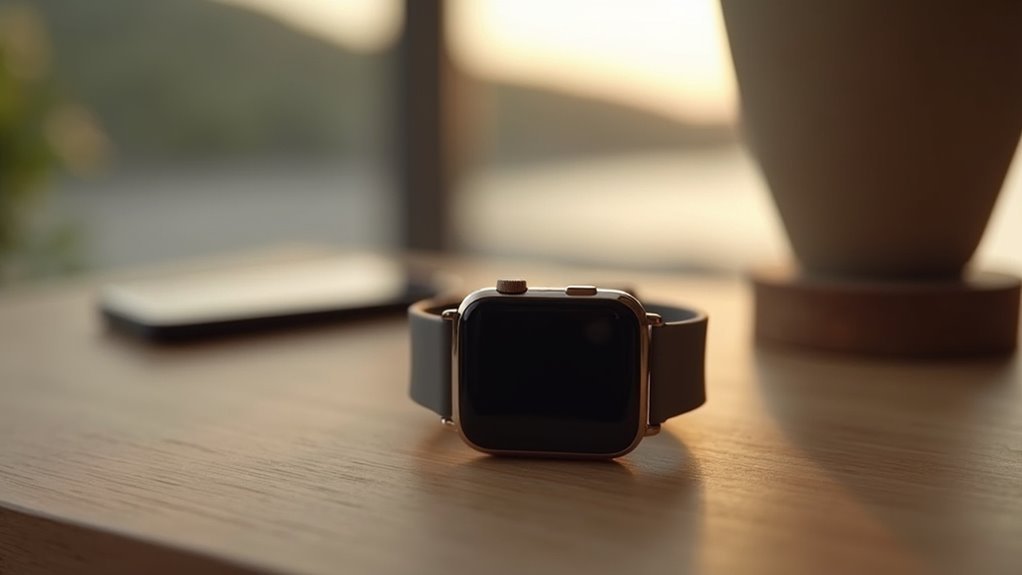
While traditional smartwatches depend on a paired smartphone for internet access, standalone cellular watches connect directly to 4G/LTE networks through embedded SIM (eSIM) technology.
You’ll find the eSIM is permanently fixed within your watch’s hardware and can’t be removed like traditional SIM cards. This technology enables you to share your phone number and carrier plan seamlessly between your smartphone and watch through software provisioning.
When you activate cellular service with a compatible carrier, your watch gains full independence. You can make voice calls, send texts, stream music, and use apps without your phone nearby. Most carriers require monthly fees for cellular smartwatch service, though these are often bundled with existing smartphone plans to reduce costs.
The eSIM allows remote activation over the air, eliminating physical SIM swapping while keeping your watch compact and lightweight for daily wear.
Top Cellular Watches for Independent Use
Now that you understand how cellular connectivity enables true independence, you’ll want to choose a watch that maximizes this freedom.
The Apple Watch Ultra 2 leads with market-best battery life and seamless cellular operation for calls, texts, and apps.
Samsung’s Galaxy Watch Ultra Series excels in rugged durability while offering thorough wellness tracking through Galaxy AI.
The Galaxy Watch 7 provides premium cellular independence with detailed health monitoring.
Google’s Pixel Watch 3 delivers the smoothest Wear OS experience for Android users, supporting calls and Google services without phone reliance. The Pixel Watch 3 features an increased battery life of up to 36 hours compared to its predecessor.
OnePlus Watch 3 offers exceptional 5-day battery life but lacks LTE connectivity, limiting true standalone capabilities compared to these cellular-enabled alternatives.
Esim Technology and Data Plan Requirements

Behind every standalone cellular watch lies eSIM technology—an embedded, rewritable chip that replaces traditional SIM cards and enables true independence from your smartphone.
This compact chip connects directly to cellular networks, allowing calls, messages, and internet access without your phone nearby.
Setting up your eSIM requires carrier support and scanning a QR code to download your digital profile.
You’ll need a smartwatch-specific data plan, which typically costs less than phone plans but offers limited data tailored for wearable usage.
These plans usually include voice, SMS, and enough data for apps and notifications. The eSIM’s non-removable nature means switching between carriers requires digital profile management rather than physical card swaps.
Before purchasing, verify your carrier supports eSIM smartwatches—availability remains limited globally, and some carriers restrict activation to specific plans or regions.
Battery Performance During Cellular Operation
When you’re using your standalone cellular watch for calls, texts, and data, you’ll notice markedly shorter battery life compared to Bluetooth-only mode.
You can extend usage time through power-saving features like Low Power Mode or Essential Mode, which some watches automatically switch to when battery runs low. The Apple Watch Ultra 2 can achieve up to 72 hours in Low Power Mode, making it particularly well-suited for extended cellular use.
The charging speed becomes vital since you’ll need to recharge more frequently – some models offer fast charging that can restore substantial battery levels in just 30-45 minutes.
Battery Life Comparison
While standalone cellular watches offer unprecedented freedom from your smartphone, this independence comes at a significant cost to battery life.
You’ll notice cellular operation drains approximately 50% more battery than Bluetooth-only modes due to constant radio activity.
Apple Watch Series 10 leads the pack with 18-21 hours including four hours of LTE use, while Samsung Galaxy Watch Ultra LTE manages only 7 hours 48 minutes under heavy cellular usage.
Google Pixel Watch 3 LTE performs similarly at 8 hours 52 minutes. Earlier Apple models like Series 4 lasted under 9 hours.
Your battery performance depends heavily on signal strength, usage patterns, and background activity. Many users report rapid battery drain when their watch switches to mobile data, particularly during activities like exercise tracking with apps such as Strava.
Weaker signals force your watch to boost transmission power, dramatically increasing consumption.
Power Saving Modes
As cellular operation pushes your smartwatch’s battery to its limits, power saving modes become essential tools for extending usage throughout the day.
You can activate these modes through Control Center on Apple Watch or Settings > Battery on Samsung Galaxy Watch.
Apple’s Low Power Mode disables Always On Display and background health measurements while limiting cellular usage until needed.
Samsung’s version uses grey screen tones and deactivates Wi-Fi and mobile networks entirely.
Both restrict CPU performance and delay non-essential notifications.
You’ll experience trade-offs: delayed notifications, disabled features, and increased manual interaction.
However, these modes greatly extend battery life during cellular use.
Apple’s mode automatically deactivates at 80% charge, while Samsung requires manual control, giving you flexibility in managing power consumption. When Low Power Mode is active, a yellow circle icon appears on your Apple Watch screen to indicate the feature is running.
Charging Speed Analysis
Since cellular connectivity demands more from your smartwatch battery than standard Bluetooth operation, understanding charging speeds becomes essential for maintaining all-day usage.
You’ll find that models like the Apple Watch Series 10 offer impressive fast charging, reaching 0–80% in just 30 minutes when paired with a compatible USB-C power adapter supporting USB Power Delivery of 5W or better.
However, you should know that cellular operation indirectly affects charging efficiency by increasing your overall power consumption. When your watch constantly transmits data and maintains network connections, it’ll drain faster even while charging.
To optimize performance, you’ll want to use higher wattage adapters and charge in cooler environments. Consider investing in a portable power bank with wireless charging capabilities for convenient charging while maintaining your active lifestyle. Remember that wireless charging typically operates at about 60% efficiency compared to wired alternatives.
Sports and Fitness Tracking Without Phone Connection
When you leave your phone behind during workouts, standalone cellular watches continue delivering extensive fitness tracking through built-in sensors and GPS functionality. You’ll record workouts including distance, pace, and calories burned independently, while heart rate monitors provide real-time health data during exercise.
| Feature | Capability | Benefit |
|---|---|---|
| Multi-GNSS Tracking | Precise location and speed data | Accurate outdoor workout metrics |
| Altimeter/Barometer | Altitude and atmospheric pressure | Enhanced hiking and climbing data |
| Workout Analysis | Performance insights and trends | Data-driven training improvements |
| Custom Workouts | Personalized routine storage | Tailored fitness programming |
Advanced models track daily activities like steps and distance walked, while offering sleep and stress monitoring without phone connection. You’ll access smart coaching features and personalized health tips directly from your wrist, ensuring thorough fitness management during phone-free activities. Many watches also support music playback capabilities with stored songs, allowing you to maintain workout motivation without carrying additional devices.
Design Features for Rugged Outdoor Activities
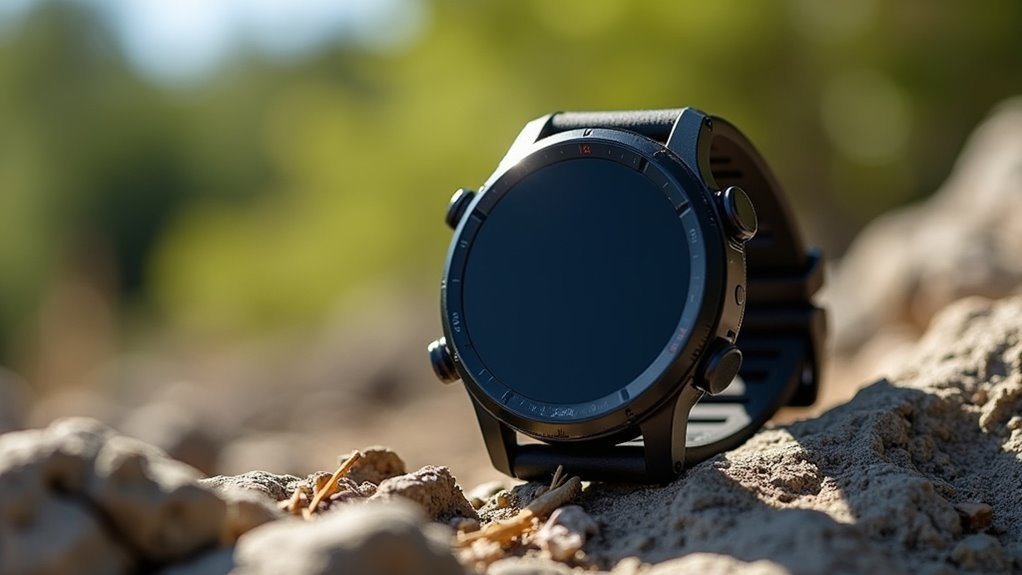
Beyond extensive fitness tracking capabilities, standalone cellular watches built for outdoor adventures prioritize robust construction and specialized features that withstand harsh environmental conditions.
You’ll find these devices offer exceptional water resistance up to 328 feet, making them suitable for swimming and unexpected water exposure. They’re constructed with durable polymers and sapphire crystal glass to resist scratches and impacts during rough activities.
These watches operate across extreme temperatures from -22°F to 158°F, meeting military standards for shock and vibration resistance.
Built to military standards, these rugged timepieces endure extreme temperatures from -22°F to 158°F while resisting shock and vibration.
You’ll appreciate their lightweight 30-50 gram designs that won’t cause fatigue during extended wear. Premium models incorporate solar charging capabilities to extend battery life indefinitely during outdoor expeditions.
Essential environmental sensors include altimeters, barometers, and electronic compasses that provide real-time altitude, weather, and directional data without requiring external devices for safe outdoor navigation.
Cost Analysis of Cellular Plans and Device Pricing
While cellular watches offer impressive standalone functionality, you’ll need to factor in ongoing monthly costs that can greatly impact your total ownership expenses.
Major carriers like AT&T, Verizon, T-Mobile, and U.S. Cellular offer plans ranging from $10 to $20 monthly.
AT&T’s plan costs $14.48 total with fees, while Verizon charges $15 but drops to $7.50 when bundled with phone service.
T-Mobile offers $10 or $15 options, and U.S. Cellular provides $10 monthly service without requiring an iPhone. T-Mobile also provides watch lines at half off pricing for $5/month when paired with qualifying Experience Beyond or Go5G Next plans.
You’ll also face one-time activation fees around $35.
Device pricing varies based on cellular capabilities, brand, and features like GPS or heart rate monitoring.
Consider both upfront device costs and long-term plan commitments when budgeting.
Frequently Asked Questions
Can I Use My Existing Phone Number on a Standalone Cellular Watch?
You generally can’t use your existing phone number on a standalone cellular watch. Most carriers require you to get a new phone number when setting up standalone cellular service for your watch.
Do Cellular Watches Work Internationally When Traveling Abroad?
Cellular watches can work internationally, but you’ll face limitations. Your carrier must support international roaming for watches, and you’ll need compatible foreign networks. Connection drops and setup challenges are common when traveling abroad.
How Much Data Do Cellular Watches Typically Consume per Month?
Your cellular watch typically consumes 300-700 MB monthly, much less than smartphones. Usage varies based on GPS tracking, app updates, and streaming features. You’ll find basic fitness tracking uses minimal data compared to feature-rich smartwatches.
Can I Make Emergency Calls Without an Active Cellular Plan?
You can usually make emergency calls without an active cellular plan on most cellular watches. Emergency numbers like 911 work through network registration requirements, not full subscription plans, depending on local regulations.
Do All Carriers Support Every Cellular Watch Model Available?
No, carriers don’t support every cellular watch model. You’ll find compatibility varies by region and carrier. Some watches are region-locked, and carriers offer different eSIM plans, so you must verify compatibility before purchasing.

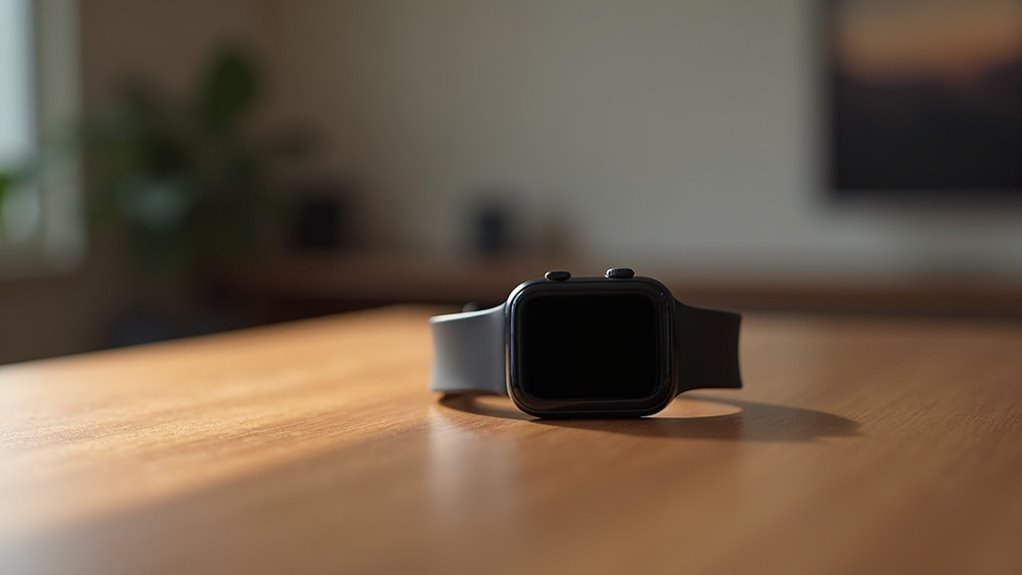

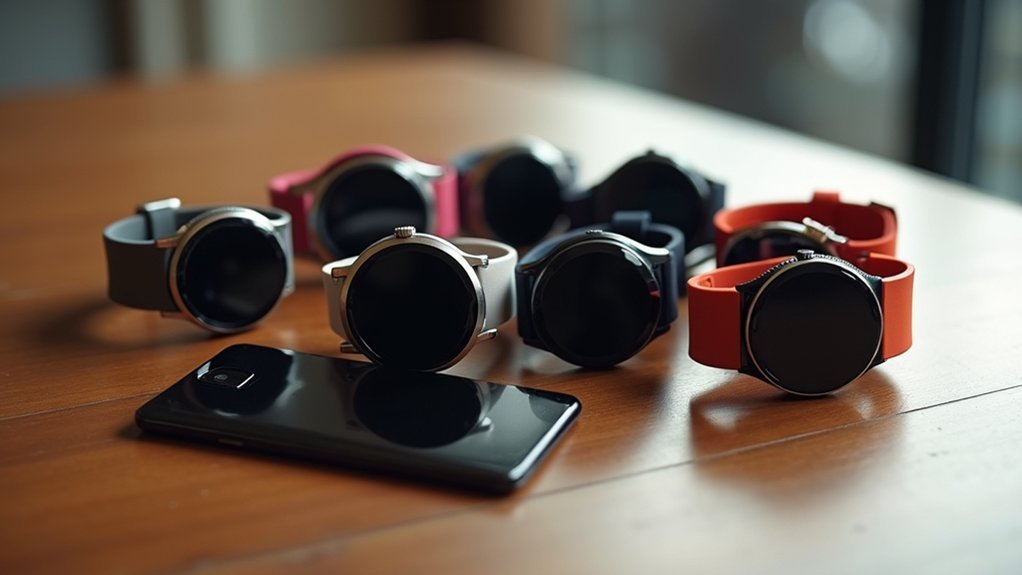
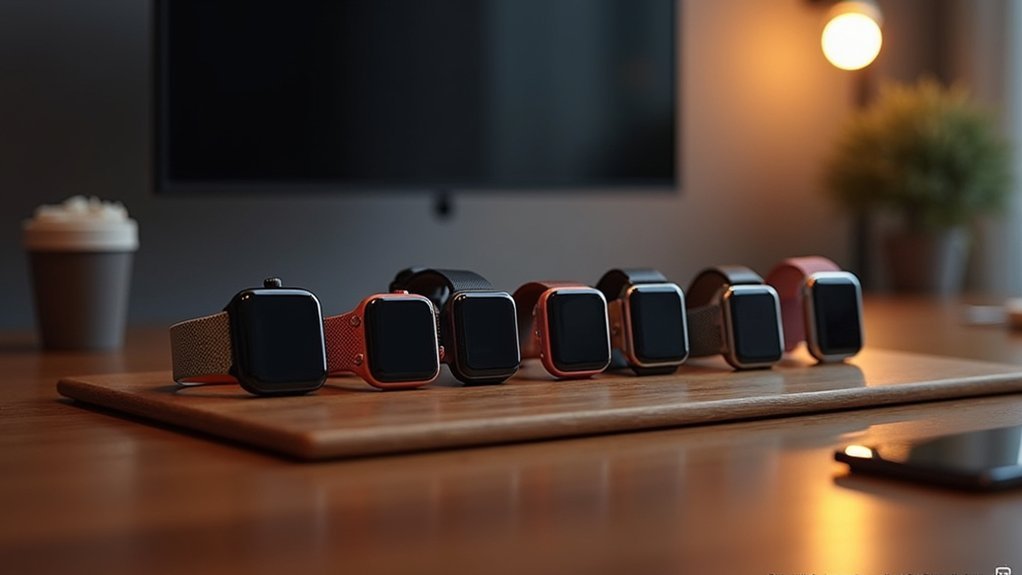
Leave a Reply